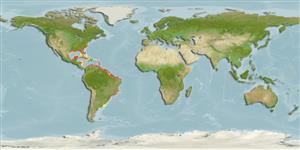>
Carangiformes (Jacks) >
Carangidae (Jacks and pompanos) > Caranginae
Etymology: Hemicaranx: Greek, hemi = the half + French, carangue, the name of a Caribbean fish; 1836 (Ref. 45335).
More on author: Cuvier.
Environment: milieu / climate zone / depth range / distribution range
Ökologie
seewasser; tiefenbereich ? - 50 m (Ref. 9626). Subtropical; 37°N - 41°S, 98°W - 34°W
Western Atlantic: North Carolina, USA and northern Gulf of Mexico southward to Florianópolis, Brazil; not found in most parts of the Lesser Antilles (Ref. 9626). Also found in Uruguay (Ref. 54736) and Argentina (Ref. 2806).
Size / Gewicht / Alter
Maturity: Lm ? range ? - ? cm
Max length : 50.0 cm TL Männchen/unbestimmt; (Ref. 26340); common length : 25.0 cm TL Männchen/unbestimmt; (Ref. 5217)
Rückenflossenstacheln (insgesamt) : 8; Rückenflossenweichstrahlen (insgesamt) : 27; Afterflossenstacheln: 3; Afterflossenweichstrahlen: 23.
Adults are coastal species. They do not form large schools (Ref. 35237). Juveniles are encountered in brackish estuaries (Ref. 5217), moving to greater depths as it grows, but not deeper than 50 m (Ref. 9626). Eggs are pelagic, spawning occurs generally in summer (Ref. 35237). Marketed fresh (Ref. 9626).
Life cycle and mating behavior
Geschlechtsreife | Fortpflanzung | Ablaichen | Eier | Fecundity | Larven
Robins, C.R. and G.C. Ray, 1986. A field guide to Atlantic coast fishes of North America. Houghton Mifflin Company, Boston, U.S.A. 354 p. (Ref. 7251)
IUCN Rote Liste Status (Ref. 130435: Version 2024-1)
Bedrohung für Menschen
Harmless
Nutzung durch Menschen
Fischereien: weniger kommerziell
Tools
Zusatzinformationen
Download XML
Internet Quellen
Estimates based on models
Preferred temperature (Ref.
123201): 22.9 - 28, mean 25.6 °C (based on 474 cells).
Phylogenetic diversity index (Ref.
82804): PD
50 = 0.5625 [Uniqueness, from 0.5 = low to 2.0 = high].
Bayesian length-weight: a=0.01122 (0.00514 - 0.02450), b=3.04 (2.87 - 3.21), in cm total length, based on all LWR estimates for this body shape (Ref.
93245).
Trophic level (Ref.
69278): 3.9 ±0.3 se; based on diet studies.
Widerstandsfähigkeit (Ref.
120179): mittel, Verdopplung der Population dauert 1,4 - 4,4 Jahre. (Preliminary K or Fecundity.).
Fishing Vulnerability (Ref.
59153): Moderate vulnerability (40 of 100).
Nutrients (Ref.
124155): Calcium = 95.3 [52.2, 207.3] mg/100g; Iron = 1.65 [0.91, 3.08] mg/100g; Protein = 20.1 [18.9, 21.3] %; Omega3 = 0.401 [0.248, 0.679] g/100g; Selenium = 19 [10, 37] μg/100g; VitaminA = 10.8 [3.5, 32.7] μg/100g; Zinc = 0.719 [0.503, 1.061] mg/100g (wet weight);
